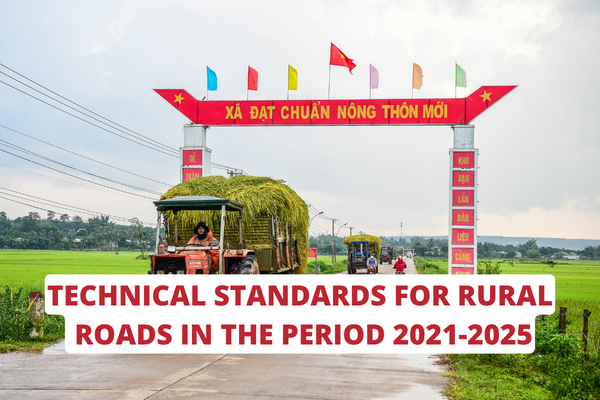Vietnam: Technical standards for rural roads in the period 2021-2025? Table of surface texture of rural roads applied to grades A, B, C, D?
Regulations on road surface, standards on slopes, curves, technical grades of rural roads?
Pursuant to Section 4, Chapter II of the Guidelines promulgated together with Decision 932/QD-BGTVT in 2022, stipulating technical standards on road surfaces:
"4.1. Road surface is the part that is directly affected by the wheels of motorized and rudimentary vehicles, as well as is directly affected by weather and climate (rain, sun, temperature, wind... ) Therefore, in order for vehicles to travel easily, the road surface needs to satisfy the following conditions:
- Must be durable (enough strength) under the effect of the load transmitted directly through the wheel to the road surface (especially with hard-wheeled animal vehicles) as well as the effects of weather and climate.
- Must be flat enough for the vehicle to move smoothly and the road surface is not stagnant.
4.2. The horizontal slope of the road surface depends on the regional rainfall and the specific type of road surface. The required horizontal slope of the road surface is from 2% to 4% (the type of road surface is asphalt concrete or cement concrete with a low value, the type of road surface without watertight surface coating is taken with a high value), the side part sugar from 4% to 5%.
4.3. It is necessary to arrange herringbone groove on the roadside so that the water in the road foundation can escape, especially for the type of pavement without watertight surface coating. The distance between herringbone grooves is usually 50 m and is arranged in staggered directions along the route. The size of the herringbone groove is usually a trapezoid with a large bottom of 50 cm facing inward, a small bottom of 30 cm facing outwards and in the direction of water flow, depth to the roadbed and covering the top surface with marginal structural material. Street. Materials for making herringbone grooves are mixed with crushed stone with sizes from 1.0 cm to 4.0 cm.
4.4. In the curve, if it is necessary to widen the roadbed as specified in Point 5.3.4 TCVN 10380:2014 “Rural roads - Design requirements”, the road surface should also be widened accordingly and should have a slope inclined towards belly side.
4.5. It is recommended to take advantage of available local materials for road surface construction to reduce road construction costs such as: crushed stone, crushed stone distribution, waste stone from quarries, kiln slag of all kinds, split stone (paving stone) ), bricks, broken bricks, pebbles, sand and gravel, hilly soil and gravel (bee gravel). It is possible to combine and mix the above materials to improve the bearing capacity and stability of the pavement layer before the impact of nature.
4.6. Depending on the technical grade, the economic conditions allow, especially for the economically developed areas, one or more layers of pavement (including the foundation layer) can be used such as: gravel pavement. asphalt screed, in situ soil reinforced with lime, cemented with asphalt screed, stone reinforced with asphalt screed, roller compacted cement concrete, asphalt concrete, cement concrete. When applying these types of pavement structures, comply with current regulations."
Thus, regulations on road surface, standards on slopes, curves, technical grades of pavements are prescribed as above.

Vietnam: Technical standards for rural roads in the period 2021-2025? Table of surface texture of rural roads applied to grades A, B, C, D?
What is the regulation on road surface structure and flatness of rural road surface of Vietnam?
Pursuant to subsection 4.7 Section 4 Chapter II Guidelines promulgated together with Decision 932/QD-BGTVT in 2022 stipulating the pavement structure and the flatness of the road surface:
"4.7. Road surface texture
a) The rural road belongs to the type of road with few vehicles (converged traffic volume in a day and night ≤ 200), so the pavement structure is allowed to be taken according to the shape. Typical new-build and rehabilitated typical rural road surface structure depending on the technical class of the road refer to Table 4, Table 5.
b) For A- and B-class highways, when more than 15% of the total vehicle traffic is heavy trucks (axle load is greater than 6000 kg), the pavement design must comply with TCCS 38:2022/TCDBVN "Road coat" soft - design requirements and guidelines” or TCCS 39:2022/TCDBVN “Design of conventional cement concrete pavements with joints in traffic construction”.
4.8. The flatness of the road surface is assessed with a 3.0 m long ruler according to TCVN 8864:2011. For pavements that are concrete or concrete, all clearances are required to be less than 5 mm, for other types all clearances are required to be less than 10 mm."
Thus, the pavement structure is regulated for low-traffic roads and for A- and B-class roads when more than 15% of the total vehicle traffic is heavy trucks as prescribed above.
Table of typical rural road surface texture applied to grade A, B, C, D of Vietnam?
Pursuant to Table 4, Table 5, Section 4, Chapter II of the Guidelines promulgated together with Decision 932/QD-BGTVT in 2022 stipulating the standards of pavement type and scope of use as follows:
Table 4 - Typical type of pavement structure of the road surface of the highway A, B, C and D

Table 5 - Minimum thickness for different types of pavement structures

LawNet
